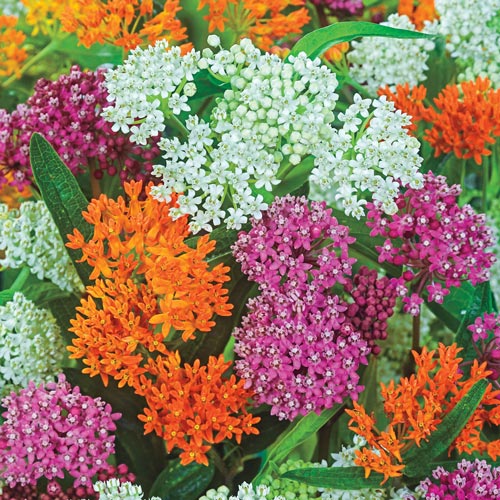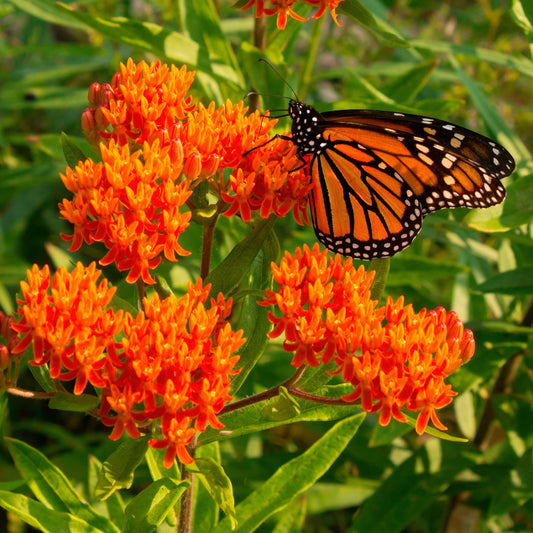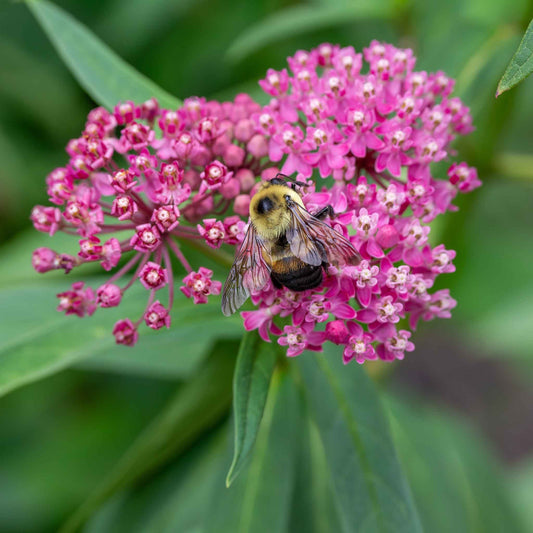-
main-collection-product-grid

Butterfly Milkweed Roots - Mix
A favorite for Monarch butterfliesOut of StockButterfly Milkweed Roots - Mix
A favorite for Monarch butterfliesRegular price As Low As $18.99Regular priceUnit price per -
main-collection-product-grid

Butterfly Milkweed Roots - Asclepias tuberosa
Pollinators will make a beeline for these fiery nectar-rich flowersOut of StockButterfly Milkweed Roots - Asclepias tuberosa
Pollinators will make a beeline for these fiery nectar-rich flowersRegular price As Low As $12.99Regular priceUnit price per -
main-collection-product-grid

Butterfly Milkweed Roots - Cinderella
This humble and hardworking perennial is a gardener's favoriteOut of StockButterfly Milkweed Roots - Cinderella
This humble and hardworking perennial is a gardener's favoriteRegular price As Low As $13.99Regular priceUnit price per
Why growing butterfly milkweed is so important
- Fragrant, nectar-rich pollinator attractor
- Deer resistant and tolerant of poor soils
- Colorful North American wildflower
- Important food source for the endangered monarch butterfly
SAVE MONARCH BUTTERFLIES FROM EXTINCTION BY PLANTING THIS NATIVE WILDFLOWER
Most of us associate milkweed with monarch butterflies, and for good reason. The monarch butterfly, the only migratory butterfly in the world, is beginning to suffer due to climate change. The herbicides used in commercial agriculture are killing native milkweed plants, leaving monarch butterflies without a food source and a safe place to lay their eggs.
Grow your own patch of milkweed and do your part to save monarch butterflies and fight against chemical-ridden, conventional agriculture! Of course, monarchs aren’t the only pollinators to benefit from these fragrant wildflowers–other butterflies, bees, wasps, and even hummingbirds depend on the butterfly milkweed to survive.
PLANT THIS POLLINATOR-FRIENDLY PERENNIAL IN SPRING FOR LASTING SUMMER BLOOMS
The lovely lilac-colored Cinderella variety is actually Swamp Milkweed, a strain of the wildflower that is particularly tolerant of wet soil. Other varieties, like the fiery Asclepias Tuberosa, prefer average, well-draining soil.
Butterfly milkweed loves full sun, so site your plants in a location that receives at least six hours of sun each day. After all danger of frost has passed, dig a hole big enough to fit the entire root clump, holding the top of the roots at soil level. Fill the hole and water your roots. Be sure to mark the planting site so you don’t forget where you planted your butterfly milkweed roots!
At the end of summer, after the blooms and foliage have begun to die back, cut the plants back to ground level to ensure new growth and healthy plants next season. The colorful, umbel-shaped flowers generally grow two feet tall and bloom from June well into August.
THIS DEER-RESISTANT ORNAMENTAL PROMISES LASTING BLOOMS FOR MANY YEARS
A treasured, deer-resistant ornamental, butterfly weed produces a chemical-ridden sap that renders it inedible to most predators–except, of course, monarch butterflies. This effective natural defense mechanism means that butterfly weed is generally problem and pest-free in the garden. As beautiful as milkweed is, its sap can irritate the skin and eyes, so always wear gloves when planting, weeding, and cutting milkweed.
Despite the name, butterfly milkweed isn’t some noxious weed that needs to end up on the compost pile. This is a native wildflower that has an important role to play in our delicate ecosystem–butterfly milkweed deserves space in everyone’s perennial flower garden!
START GROWING THIS PROLIFIC PLANT WITH QUALITY ROOTS
Butterfly milkweed is a vigorous reseeder, so either cut back the seedpods before they mature, or plant milkweed roots in containers to control the spread. If you’d rather not wait to exponentially grow your butterfly milkweed meadow, go ahead and order in bulk! You’ll save money and the first flush of color from your pollinator garden will be priceless.
At Eden Brothers, we care deeply about connecting home gardeners with quality seeds, bulbs, and roots. We source our perennial rootstock from quality suppliers, and quality check your order before it ever leaves our warehouse. We want to streamline the process from ordering to planting, so we wait to ship your milkweed roots to you until the ideal planting window for your growing zone.
Need a primer on butterfly milkweed? Check out this growing guide for everything you need to know about planting butterfly milkweed roots.


